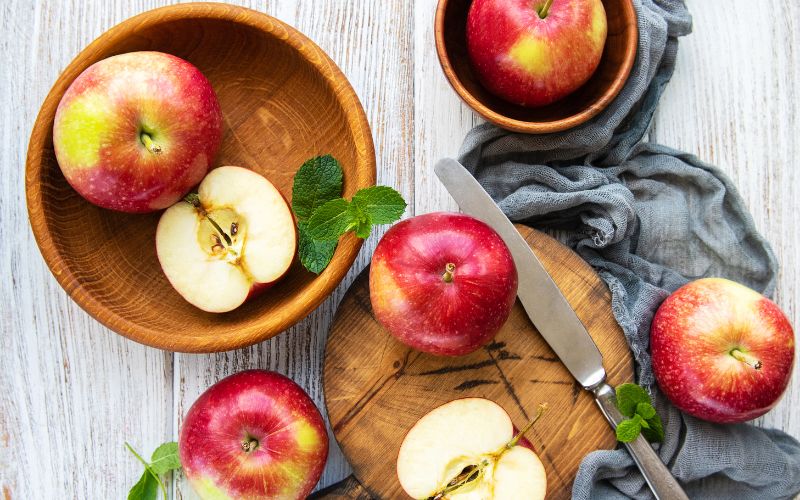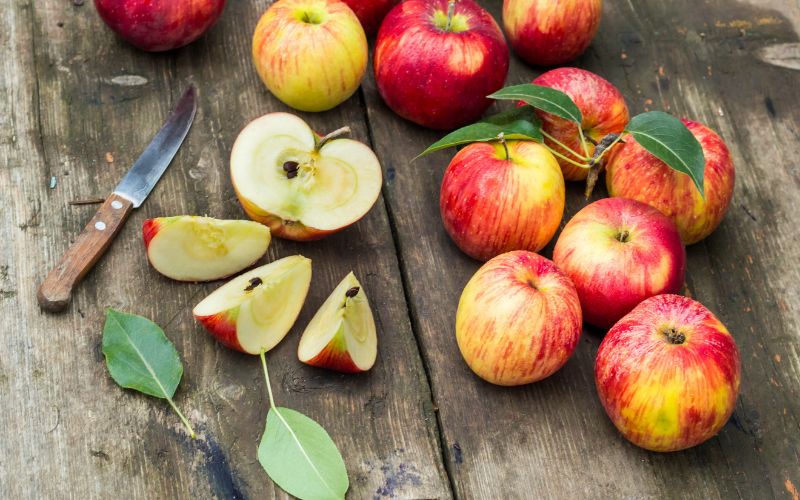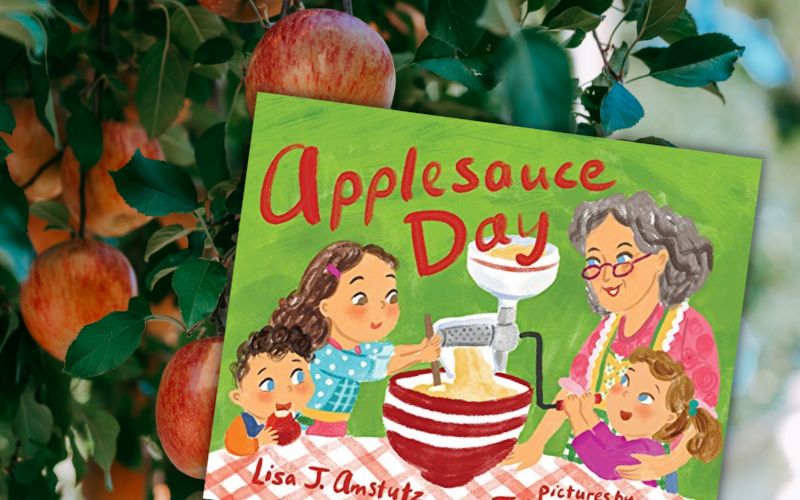Apple Unit Study: Fun and Engaging Educational Activities
An apple unit study can be a delightful and educational way to engage your children in hands-on learning. Apples are not only a symbol of the fall season but also represent the beginning of the school year. By incorporating apple-themed lessons and activities into your homeschool curriculum, you create memorable experiences for your young learners.

In an apple unit study, you can easily combine various subjects such as science, math, and history. For example, you might teach your child about the life cycle of apple trees, explore the properties of different apple varieties, and discuss the historical significance of apple farming.
The diverse range of topics allows you to tailor the educational experience to your child’s unique interests and capabilities, ensuring a fruitful and enjoyable learning experience for both you and your little one.
To make the most of your apple unit study, consider incorporating hands-on activities, such as visiting a local apple orchard or participating in apple-themed art projects. By immersing your child in engaging and interactive lessons, you’re setting the stage for a successful homeschooling adventure.
Fundamentals of Apple Unit Study
Apple Life Cycle
As you delve into an apple unit study, understanding the apple life cycle will be an essential part of your learning journey. In autumn, apples mature and fall from the tree, making it the perfect time for apple picking.
The life cycle of an apple starts with a seed, which grows into a young tree during spring. Following that, blossoms appear on the tree, turning into fruit in the summer. By the time September rolls around, the apples are ready to be harvested.
Activities & Printables:
- Life Cycle of an Apple Tree Wheel: Free Printable Activity
- Life Cycle of an Apple Activities
- Apple Life Cycle Spinner
Apple Tree Anatomy
Familiarizing yourself with the parts of an apple tree will enhance your study experience. Key components include the roots, trunk, branches, leaves, and fruit. The roots anchor the tree into the ground while absorbing nutrients and water to support growth. The trunk and branches provide structure and proper sunlight exposure. Leaves are essential for photosynthesis, and the fruit houses the seeds, which will grow into new apple trees.
- Roots: Absorb nutrients and water
- Trunk: Provides structure
- Branches: Support leaves and fruit
- Leaves: Assist in photosynthesis
- Fruit: Contains seeds for propagation
Activities & Printables:
Varieties of Apples
Did you know there are more than 7,500 varieties of apples worldwide? Each type has its unique flavor, texture, and appearance. As part of your apple unit study, consider exploring some of these different varieties and their characteristics.
Some popular varieties include:
- Red Delicious: Sweet and mild flavor, perfect for snacking
- Granny Smith: Tart and crunchy, ideal for pies and baking
- Fuji: Sweet and crisp, great for eating fresh or in salads
- Gala: Mildly sweet and versatile for cooking or eating
- Honeycrisp: Exceptionally crisp and juicy, perfect for snacking and cooking
Incorporating these fundamentals into your apple unit study will provide a well-rounded understanding of apples, their life cycle, anatomy, and various types. Delve into this fascinating topic during the fall season and enjoy discovering the world of apples.
Why not have an apple tasting to see which ones you like best? You can ask your children what they like best about particular apples and if they are old enough they could write a report about the different apples and flavors.
Make a recipe with apples!
Here are a few fun and easy apple recipes for kids:
- Apple Slices with Nut Butter: Slice apples into wedges and provide an assortment of nut butter options like peanut butter, almond butter, or cashew butter. Allow your children to dip the apple slices into the nut butter for a simple and nutritious snack.
- Apple Quesadillas: Place a tortilla on a skillet over medium heat. Sprinkle shredded cheddar cheese on one half of the tortilla, then layer sliced apples on top. Fold the tortilla in half and cook until the cheese melts and the tortilla turns golden brown. Let your kids assist with assembling and flipping the quesadillas.
- Apple and Cheese Kabobs: Cut apples into cubes and alternate threading them onto skewers with cubes of mild cheese, such as cheddar or Monterey Jack. This recipe encourages creativity and provides a fun and healthy snack option.
I have more apple recipes for kids you can use in your themed apple unit study as part of your homeschool here.
Integrating Subjects in an Apple Unit Study
Mathematics and Apples
Apples can be a fun and engaging way to teach your children math. You can start with simple activities such as counting apples, sorting them by color or size, and even creating addition worksheets. Fractions can also be easily taught using apples as examples. Cut apples into halves, thirds, or quarters and let your children explore how the fractions relate to the whole apple.
- Apple Tree Counting Worksheet for Kids
- 7 Math Activities With Numbered Apples
- 6 Apple Themed Math Activities
- Apple Math Activities that are So Appealing

Apple Art and Crafts
Encourage your children’s creativity with various apple-themed art projects and crafts. From coloring pages to creating apple prints with paint, there are endless possibilities to keep little hands busy and minds engaged. Handprint apple trees or apple stamping are other fun and educational activities you can introduce.
Literature and Reading
Apple unit studies can incorporate a wide range of books and literature related to apples, Johnny Appleseed (John Chapman), and fall-themed stories. Create a book list with various genres such as picture books, biographies, and poetry.
Reading and analyzing books like Robert Frost’s poem “After Apple Picking” can lead to interesting discussions and comprehension activities:
After Apple-Picking
BY ROBERT FROSTMy long two-pointed ladder’s sticking through a tree
Toward heaven still,
And there’s a barrel that I didn’t fill
Beside it, and there may be two or three
Apples I didn’t pick upon some bough.
But I am done with apple-picking now.
Essence of winter sleep is on the night,
The scent of apples: I am drowsing off.
I cannot rub the strangeness from my sight
I got from looking through a pane of glass
I skimmed this morning from the drinking trough
And held against the world of hoary grass.
It melted, and I let it fall and break.
But I was well
Upon my way to sleep before it fell,
And I could tell
What form my dreaming was about to take.
Magnified apples appear and disappear,
Stem end and blossom end,
And every fleck of russet showing clear.
My instep arch not only keeps the ache,
It keeps the pressure of a ladder-round.
I feel the ladder sway as the boughs bend.
And I keep hearing from the cellar bin
The rumbling sound
Of load on load of apples coming in.
For I have had too much
Of apple-picking: I am overtired
Of the great harvest I myself desired.
There were ten thousand thousand fruit to touch,
Cherish in hand, lift down, and not let fall.
For all
That struck the earth,
No matter if not bruised or spiked with stubble,
Went surely to the cider-apple heap
As of no worth.
One can see what will trouble
This sleep of mine, whatever sleep it is.
Were he not gone,
The woodchuck could say whether it’s like his
Long sleep, as I describe its coming on,
Or just some human sleep.

Classic Books with Apple Themes for Kids
When it comes to classical literature that can be enjoyed with kids and revolves around the theme of apples, there are a few notable choices that come to mind. These stories not only entertain young readers but also offer valuable lessons and insights. Here are a few recommendations:
- “Snow White” by the Brothers Grimm: This timeless fairy tale features the iconic scene where Snow White is tempted by a poisoned apple given to her by the wicked queen. The story teaches children about jealousy, kindness, and the importance of making wise choices.
- “Johnny Appleseed” by Jodie Shepherd: This picture book introduces children to the legendary American folk hero, Johnny Appleseed. The story follows Johnny’s adventures as he travels across the country planting apple trees and spreading kindness. It showcases the value of generosity, love for nature, and the significance of nurturing and caring for living things.
- “The Apple Pie Tree” by Zoe Hall: In this beautifully illustrated book, children learn about the life cycle of an apple tree throughout the seasons. The story follows two young sisters who observe the tree in their backyard, from the emergence of buds and flowers to the growth of tiny apples and their eventual harvest. It’s an engaging way to teach kids about nature, patience, and the rewards of hard work.
- “Ten Apples Up On Top!” by Dr. Seuss: This fun and rhyming book by Dr. Seuss will have young readers counting and laughing along. It features animal characters balancing apples on their heads, leading to a hilarious competition. The story promotes early math skills, teamwork, and the joy of play.
- “The Apple and the Arrow” by Mary and Conrad Buff: Set in medieval Switzerland, this historical fiction book revolves around the life of William Tell, a legendary archer. Although apples are not the central focus, they play a pivotal role in the famous scene where William Tell is forced to shoot an apple off his son’s head with an arrow. This gripping adventure story teaches children about bravery, family bonds, and the power of trust.
- “Little House in the Big Woods” by Laura Ingalls Wilder: Part of the beloved “Little House” series, this autobiographical novel describes the early life of Laura Ingalls Wilder as she grows up in a log cabin in the Wisconsin woods. The book includes vivid descriptions of the family’s apple orchard, depicting the process of harvesting and preserving apples for the winter. It provides insights into pioneer life, self-sufficiency, and the importance of seasonal food preservation. You could even make a clove apple like Ma Ingalls!
These books offer a range of reading experiences for kids, from moral lessons to nature exploration, while incorporating the theme of apples. They are timeless classics that can be enjoyed by children and parents alike, creating memorable reading moments and fostering a love for literature.
Apple Science Experiments
Explore the science behind apples with experiments and hands-on activities for your homeschoolers. Investigate the life cycle of an apple, learn about apple varieties, and delve into the anatomy of an apple. STEM activities like constructing apple towers or designing apple container carriers can encourage your children’s curiosity and creativity.
#1 Apple Dissection: Uncover the inner workings of an apple by conducting an apple dissection. Slice an apple horizontally and vertically to reveal its different parts, such as the skin, flesh, core, and seeds.
Encourage your children to observe and compare the structures, discussing their functions and how they contribute to the apple’s growth and reproduction. This activity provides a hands-on introduction to plant anatomy and fosters scientific observation skills.
#2 Oxidation Experiment: Explore the process of oxidation by conducting a simple experiment with apple slices. Cut an apple into thin slices and divide them into different groups. Leave one group exposed to the air, cover another group with lemon juice, and cover the remaining group with water. Observe how each group changes over time.
The group covered with lemon juice should exhibit slower browning due to the presence of antioxidants. This experiment teaches kids about oxidation and the effects of different treatments on the apple’s browning process.
#3 Apple Float or Sink: Investigate buoyancy by testing whether apples float or sink in water. Predict and then immerse various types of apples (e.g., Granny Smith, Red Delicious) in a container filled with water. Observe and record the results.
Discuss the factors that contribute to an object’s ability to float or sink, such as density and displacement. This activity introduces concepts related to physics and engages children in scientific prediction and observation.
#4 Apple Taste Test: Conduct an apple taste test to explore the diversity of flavors and textures among different apple varieties. Gather several apple types, ensuring you include popular varieties like Granny Smith, Red Delicious, and Honeycrisp. Blindfold your children and have them taste small pieces of each apple, one at a time.
Ask them to describe the taste, texture, and any other observations they make.
Afterward, reveal the apple names and discuss their preferences. This activity allows kids to use their senses and practice descriptive skills while learning about apple varieties.

History and Social Studies
Integrate history and social studies into your apple unit study by teaching your students about the legend of Johnny Appleseed and his impact on American history. You can also explore the cultural importance of apples in different societies and include a field trip to an apple orchard or museum to provide a hands-on learning experience.
Apples have a rich history and cultural significance that can be woven into engaging activities for homeschoolers. In addition to scientific exploration, incorporating history and social activities can provide a well-rounded understanding of apples and their impact on society. Whether you’re homeschooling or looking for educational activities to do with your children, here are some exciting ideas to delve into the history and social aspects of apples. Get ready to discover the apple’s journey through time and its influence on our lives!
#1 Apple History Timeline: Create an apple history timeline with your homeschoolers. Research and discuss key events and milestones related to apples, such as the cultivation of different apple varieties, the introduction of apples to new regions, or the discovery of the apple’s genetic diversity.
Use this timeline as a visual representation of how apples have evolved over centuries and spark conversations about the historical significance of this fruit.
#2 Apple Folklore and Legends: Explore the folklore and legends surrounding apples from various cultures. Discover stories like the legend of Johnny Appleseed in American folklore or the story of the golden apples in Greek mythology.
Read these tales together and engage your children in discussions about the cultural and symbolic meanings of apples in different societies. Encourage them to create their own apple-inspired stories or artwork based on the folklore they have learned.
#3 Apple Orchard Visit: Plan a field trip to a local apple orchard or farm. Many orchards offer educational programs that provide hands-on experiences, such as apple picking, cider pressing, or learning about the different apple varieties. Engage with the farmers or guides to learn about the history of the orchard, its operations, and the significance of apples in the local community. This interactive outing allows children to connect with the agricultural aspect of apple cultivation and gain insights into the social and economic impact of orchards.
Art and Music Study
Incorporate art and music into your apple unit study by studying famous paintings with apples, like Paul Cézanne’s “The Basket of Apples” or asking your children to create their own apple-inspired masterpieces.
Musical activities can include learning traditional songs about apples or Johnny Appleseed or composing their own apple-themed tunes.
Remember, variety is key, and incorporating diverse and fun activities will ensure that your apple unit study is a success.
Enhancing Learning Experience
Field Trips and Activities
Taking your child on field trips can greatly enhance their learning experience during an apple unit study. Visiting an apple orchard or farmer’s market allows your little learners to experience different apple varieties, colors, and flavors firsthand. While at an orchard, children may even have the opportunity to participate in apple-picking and cider-making activities.
#1 Apple Orchard Visit: A visit to an apple orchard is a classic field trip that offers a wealth of learning opportunities. Contact local orchards in your area and arrange a guided tour specifically tailored to your homeschool group.
During the visit, your children can learn about apple cultivation, the process of harvesting, and the various apple varieties grown on the orchard. They can also participate in apple picking, getting a hands-on experience of selecting ripe apples straight from the trees.
Some orchards may even offer activities like cider pressing demonstrations or apple taste testing sessions. This field trip allows children to connect with the agricultural aspect of apple production and witness firsthand the seasonal changes that impact apple growth.
#2 Apple Cider Mill Tour: Take your homeschoolers on a field trip to an apple cider mill or a local cider press. Here, they can observe the process of turning apples into fresh apple cider. They’ll learn about the different steps involved in cider making, such as washing, grinding, pressing, and pasteurization.
During the tour, they can also discover the history of cider making and its cultural significance. Some cider mills may offer interactive activities like apple tastings, cider sampling, or even the opportunity to make their own small batch of cider.
This field trip provides a hands-on experience that connects children to the traditional methods of apple processing and exposes them to the wonderful flavors of freshly pressed apple cider.
#3 Apple Festival or Farmers Market: Check if there are any local apple festivals or farmers markets happening in your area. These events often showcase an array of apple varieties, local produce, crafts, and educational activities related to apples.
Visiting an apple festival or farmers market allows homeschoolers to immerse themselves in the vibrant atmosphere of apple-centric celebrations. They can explore different apple varieties, taste unique apple-based products, participate in apple-themed games or competitions, and engage with local growers and artisans.
This field trip offers a lively and interactive experience that exposes children to the wider apple community and fosters a sense of connection to local food culture.
Frequently Asked Questions
What is the apple life cycle?
The apple life cycle begins when a new apple tree grows from a seed or graft. The tree matures and blossoms, producing flowers that are pollinated by insects, especially bees. Pollinated flowers develop into small fruits, which continue to grow and ripen over several months. Once the apples are ripe, they can be harvested, and the cycle begins anew with new seeds or grafting material.
What nutrients do apples provide?
Apples are a nutrient-rich fruit, providing essential vitamins and minerals such as vitamin C, potassium, and dietary fiber. They are also a good source of antioxidants, which help protect your body from damage caused by free radicals. Incorporating apples into your diet can support your overall health, including heart health, digestion, and immune function.
What are apple varieties?
There are thousands of apple varieties, each with its unique taste, texture, and appearance. Some popular types include Gala, Granny Smith, Red Delicious, and Fuji apples, as well as more specialized varieties like Honeycrisp and Pink Lady. Many apples are grown for specific purposes, such as eating fresh, baking, or making cider.
Conclusion
In conclusion, we’ve explored various aspects of an apple unit study, from scientific perspectives to the historical and cultural significance of apples. I hope you enjoy using this apple-themed unit with your children!



